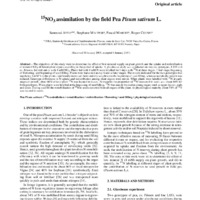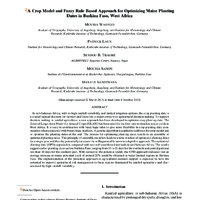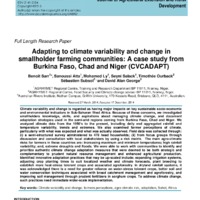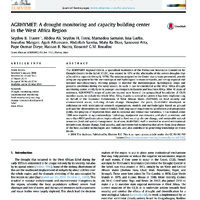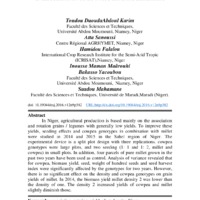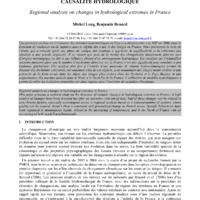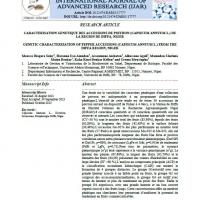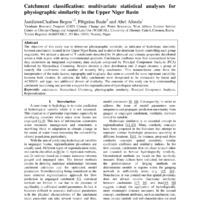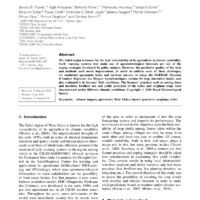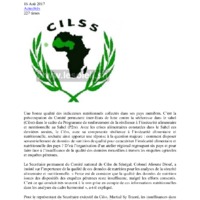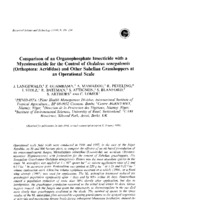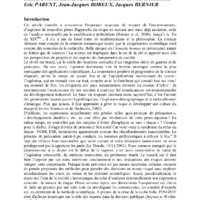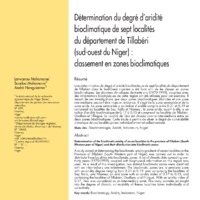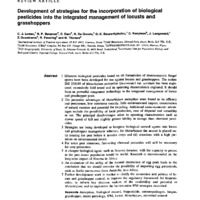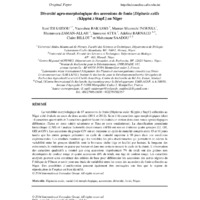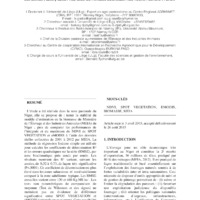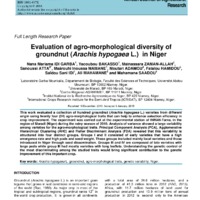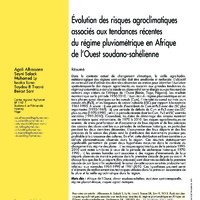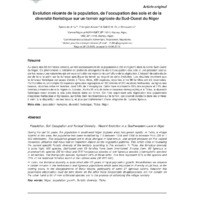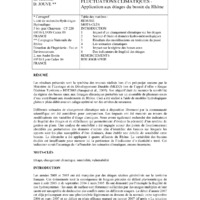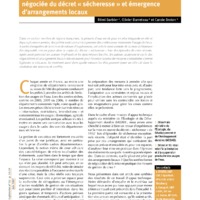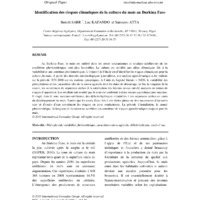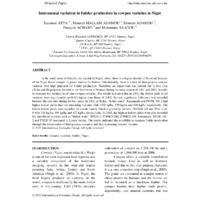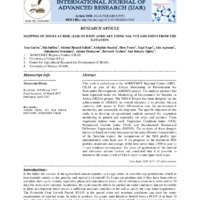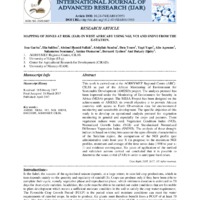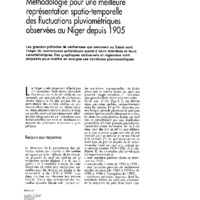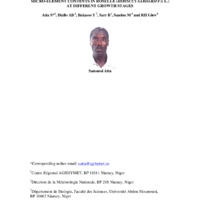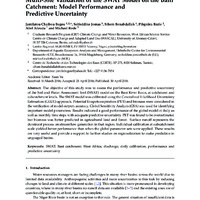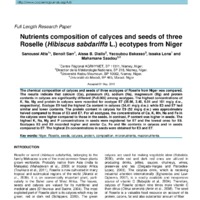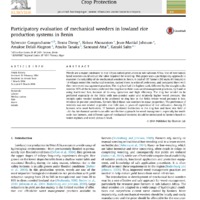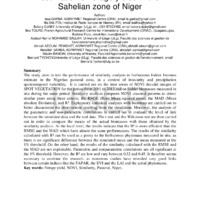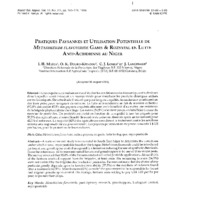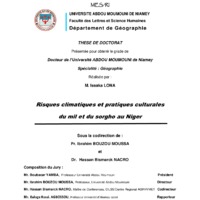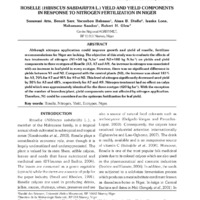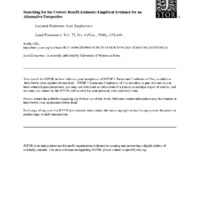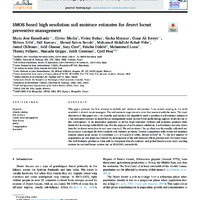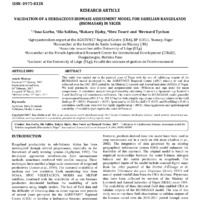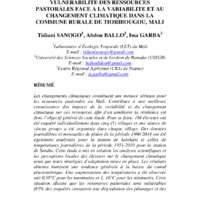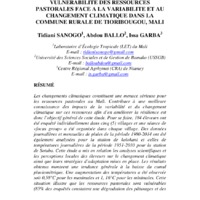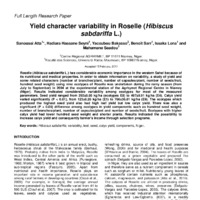Recherche
53 items
15NO3 assimilation by the field Pea Pisum sativum L.
Abstract – The objectives of this study were to determine the effect of low mineral supply on plant growth and the uptake and redistribution of mineral N by different plant organs according to the period of uptake. A glasshouse study was conducted on two pea genotypes, L833 and cv. Frisson, fed without or with 4 mM NO3. Plants fed with 4 mM N were labelled for 5 days with 15N at three stages: 7 leaf stage, beginning of flowering, and beginning of seed filling. Plants were harvested at day 6 and at later stages. The results indicated for the two genotypes that supplying 4 mM N to the plants significantly increased their total dry weight up to the beginning of seed filling, whereas nodule dry weight was reduced. Genotype differences in N uptake and redistribution among plant organs were minor. When plants were labelled with 15N at early stages of growth, about 60& of total plant 15N was located in leaves. At maturity the proportion of 15N recovered in seeds was about 60& for both genotypes. When plants were labelled at the beginning of seed filling, 15N was mainly located in young organs such as upper leaves, pods and seeds. During seed fill the remobilisation of 15N to seeds occurred from all organs of the plant. At physiological maturity about 70& of 15N was located in seeds.
A Crop Model and Fuzzy Rule Based Approach for Optimizing Maize Planting Dates in Burkina Faso, West Africa
In sub-Saharan Africa, with its high rainfall variability and limited irrigation options, the crop planting date is a crucial tactical decision for farmers and therefore a major concern in agricultural decision making.
Adapting to climate variability and change in smallholder farming communities: a case study from Burkina faso, Chad and Niger
Climate variability and change is regarded as having major impacts on key sustainable socio-economic and environmental indicators in Sub-Saharan West Africa. Because of these concerns, we investigated smallholders knowledge, skills, and aspirations about managing climate change, and document adaptation strategies used in the semi-arid regions coming from Burkina Faso, Chad and Niger. We analyzed climate data from the 1950’s to the present, including daily and aggregated rainfall and temperature variability, trends and extremes.
AGRHYMET: Adrought monitoring and capacity building center in the West Africa Region
The AGRHYMET Regional Center, a specialized institution of the Permanent Interstates Committee for Drought Control in the Sahel (CILSS), was created in 1974 at the aftermaths of the severe droughts that affected this region in the early 1970s. The mission assigned to the Center was to train personnel, provide adequate equipment for the meteorological and hydrological stations networks, and set up regional and national multidisciplinary working groups to monitor the meteorological, hydrological, crops and pastures conditions during the rainy season. As such, it can be considered as the West Africa drought monitoring center, similarly to its younger counterparts in Eastern and Southern Africa. After 40 years of existence, AGRHYMET’s scope of activities expend now beyond the geographical boundaries of CILSS member states, to include the whole West Africa thanks to several initiatives it has been implementing on behalf of the Economic Commission of West African States (ECOWAS) on food security and environmental issues, including climate change. Throughout the years, AGRHYMET developed, in collaboration with international research organizations, models and methodologies based on ground and satellite observations to monitor rainfall, food crop water requirements satisfaction and prospective yields, the progress of vegetation front and its seasonal and interannual variations. It has trained about 1200 new experts in agrometeorology, hydrology, equipment maintenance, and plant protection, and more than 6000 professionals on topics related to food security, climate change, and sustainable natural resources (land and water) management. As of now, AGRHYMET staff is involved in several international initiatives on climate change, food security, and environmental monitoring that allow them keep abreast of the best available technologies and methods, and also contribute to generating knowledge on those issues.
Amelioration Du Rendement Du Mil Par L’association Avec Le Niebe En Zone Sahelienne
Au Niger, la production agricole est essentiellement basée sur l’association et la rotation céréales/légumineuses avec des rendements généralement faibles. Afin d’améliorer ces rendements, les effets de densités de semis et de génotypes de niébé en association avec le mil ont été étudiés en 2014 et 2015 en zone sahélienne du Niger. Le dispositif expérimental est un split plot à trois répétitions. Les génotypes de niébé étaient en grandes parcelles, et les deux densités de semis (1 :1 et 1 :2, mil et niébé) en petites parcelles. Par ailleurs, quatre parcelles de mil pur cultivées au cours des deux années ont été utilisées comme témoin. L’analyse de variance révèle que pour le niébé, le rendement en biomasse, en graines, le poids de cent graines et l’indice de récolte en graines ont été significativement affectés par les génotypes pendant les deux années. Cependant, il n’y’avait aucun effet significatif de la densité et de génotypes de niébé sur les rendements en grains du mil. En 2014, le rendement en biomasse de mil à la densité 2 était inférieur à celui de la densité 1. La densité 2 augmentait les rendements du niébé et diminuent faiblement ceux du mil.
Analyse de l’évolution spatio-temporelle des dérivés pluviométriques caractérisant la saison agricole au Sahel - Central
L’objectif de cette étude est d’analyser l’évolution spatio-temporelle des dérivés pluviométriques impactant la qualité de la saison agricole, notamment les périodes de début et de fin de saison, le cumul des pluies, le nombre de jours des pluies, la longueur de la saison et les séquences sèches. Elle s’appuie sur l’analyse des données journalières de 1951 à 2010 de 98 stations météorologiques. Les dérivés pluviométriques sont
d’abord identifiés, ensuite, des indices adaptés sont utilisés pour caractériser leurs évolutions. Ces dérivés présentent des fortes variabilités spatiales et temporelles. Cela a permis de subdiviser la région en quatre (4) zones avec des caractéristiques moyennes très distinctes.
Analyse régionale sur les extrêmes hydrometriques en France: Détection de changement cohérents et recherche de causalité hydrologique
Une première analyse sur l’évolution des extrêmes hydrométriques en France a été présentée à la SHF en 2006, pour la détection de tendances ou de ruptures dans le régime des crues et des étiages en France. Nous présentons la suite de
l’étude, qui a consisté après une phase de critique des résultats à apprécier la significativité et la cohérence des résultats à une échelle régionale. Il en ressort que près de la moitié des changements initialement détectés sont d’origine métrologique ou liés à une influence directe d’un aménagement hydraulique. Les résultats sur l’échantillon restreint montrent alors que le nombre d’évolutions détectées sur la France n’est pas significatif pour conclure à une évolution généralisée. Une analyse plus fine à l’échelle d’une quinzaine de régions hydro-climatiques permet de détecter des évolutions cohérentes sur seulement cinq de ces régions, avec notamment des étiages moins sévères et une
précocité de la fonte nivale dans les Alpes, des étiages plus sévères dans les Pyrénées et le Pays Basque, et une
augmentation des maxima annuels dans le Nord et le Nord-Est de la France. L’utilisation de modèles hydrologiques a
permis de relier les évolutions constatées sur deux régions avec l’évolution de variables climatiques.
Caractérisation génétique des accessions de poivron (Capsicum Annum L.) de la Région de Diffa, Niger
Une étude sur la variabilité des caractères génétiques d'une collection de poivron est indispensable à un programme d'amélioration génétique. L’objectif de cette étude est de tester 30 accessions de poivron suivant un dispositif de Fisher à 4 blocs, à la Station de Diffa de l'Institut National de la Recherche Agronomique du Niger (INRAN).6 caractères qualitatifs et 16 caractères quantitatifs ont été observés et mesurés. Les caractères qui traduisent une grande variation (CV>30 %) sont le nombre total des fruits (83,98%), le poids des fruits (62,86%), la longueur des fruits (42,48%) et la surface foliaire (30,48%). L’accession Go-027 a été plus performante en nombre total des fruits (57 fruits) et quant aux accessions Ma-032 et Ma-033, elles ont été plus performantes pour la longueur des fruits. Une forte et positive corrélation existe entre plusieurs caractères dont phénologiques (Dat50Fl et Dat1Fr, p=080), de croissance (LgFe et Srfo, p=0,93)et de rendement (PdFr et LgFr, p=0,72).Pour tous les paramètres, la variance phénotypique (σ2p) était supérieure à la variance génotypique (σ2g). La hauteur des plantes (67,66%), la largeur des fruits (65,76%) et le diamètre des fruits (64,09) présentent des valeurs d'héritabilité au sens large élevées (H2 ˃60 %).L’analyse en composante principale (ACP) et la classification ascendante hiérarchique (CAH) ont montré la formation de 4 groupes distinctes. Le groupe G1esttardif avec une grande hauteur associé à un faible poids en fruits, le groupe G2 est composé des accessions intermédiaires, le groupe G3 est tardif avec moins de hauteur et plus de rendement en poids des fruits. Enfin le groupe G4 est précoce, avec une grande hauteur et un bon couvert végétal associé a des fruits longs. Cette caractérisation offre un matériel génétique aux chercheurs leur permettant d’améliorer le potentiel de rendement en fruits commercialisables.
Catchment classification: multivariate statistical analyses for physiographic similarity in the upper niger basin
The objective of this study was to determine physiographic similarity, as indicator of hydrologic similarity between catchments located in the Upper Niger Basin, and to derive the dominant factors controlling each group singularity. We utilized a dataset of 9 catchments described by 16 physical and climatic properties distributed across a wide region with strong environmental gradients. Catchments attributes were first standardized before they underwent an integrated exploratory data analysis composed by Principal Component Analysis (PCA) followed by Hierarchical Clustering. Results showed a clear distribution into 2 major clusters: a group of easterly flat catchments and another of westerly hilly catchments. This nomenclature came from the interpretation of the main factors, topography and longitude, that seem to control the most important variability between both clusters. In addition, the hilly catchments were designated to be dominated by forest and ACRISOL soil type, two additional drivers of similarity. The outcome of this study can help understanding catchment functioning and provide a support for regionalization of hydrological information.
Characterizing and modeling the diversity of cropping situations under climatic constraints in west africa
The Sahel region is known for the high vulnerability of its agriculture to climate variability. Early warning systems that make use of agrometerological forecasts are one of the coping strategies developed by policy makers. However, the predictive quality of the tools and methods used needs improvement. In order to address some of these challenges, we conducted agronomic trials and on-farm surveys to adapt the SARRAH (Syst`eme d’Analyse R´egionale des Risques Agroclimatiques, version H) crop simulation model, and also evaluated it in farmers’ field conditions. The farmers’ practices such as sowing dates and densities, fertilizer use and yields potentials of the millet and sorghum crops were characterized under different climatic conditions.
Détermination du degré d’aridité bioclimatique de sept localités du département de tillabéri (sud-ouest du niger): classement en zones bioclimatiques
Une détermination du degré d’aridité bioclimatique de sept localités du département de Tillabéri dans le Sud-Ouest nigérien a été faite afin de les classer en zones bioclimatiques. Les données climatiques de trente ans (1970-1999), couplées avec des informations biophysiques de cette région ont été utilisées pour cet exercice. Il ressort de ces investigations que deux zones bioclimatiques distinctes et une zone intermédiaire peuvent être mises en évidence. Il s’agit de la zone semi-aride et de la zone aride. La zone semi-aride a un indice d’aridité compris entre 0,21 et 0,19 et comprend les localités de Say, Kollo et Niamey ; la zone aride, quant à elle, a un indice d’aridité bioclimatique de 0,17 à 0,15 et comprend les localités de Tillabéri, Ouallam et Fillingué. La localité de Téra est classée comme intermédiaire entre les deux zones bioclimatiques.
Diversité agro-morphologique des accessions de fonio [Digitaria exilis (Kippist.) Stapf.] au Niger
La variablité morphologique de 67 accessions de fonio [Digitaria exilis (Kippist.) Stapf.] collectées au Niger a été évaluée au cours de deux années (2011 et 2012). Seize (16) caractères agro morphologiques (dont 14 caractères quantitatifs et 2 caractères qualitatifs) ont été évalués en station dans deux zones agroécologiques différentes (Tarna en zone sahélo-saharienne et Tara en zone soudanienne). La classification acsendante hierarchique (CAH) et l’analyse factorielle discriminante (AFD) ont mis en évidence quatre groupes (GI, GII, GIII et GIV). Les accessions du groupe GIV ont en moyenne un cycle de maturité compris entre 85 et 90 jours tandis que les autres groupes présentent un cycle de maturité superieur à 90 jours dans nos conditions expérimentales. Les résultats montrent que les variables les plus discriminantes qui permettent de décrire la variabilité entre les groupes identifiés sont la biomasse sèche (tige et feuille) par hectare, la longueur des entrenoeuds, le rendement en graine par hectare et dans une certaine mesure le cycle de la plante. L’observation des caractères qualitatifs a montré que cinq accessions (représentant 7& du total) ont des graines non decortiquées de couleur rouge et quatre accessions (6& du total), une tige de couleur rouge. Les caractères analysés peuvent ainsi constituer des critères de base pour différencier les accessions des autres régions de l’Afrique de l’Ouest et servir pour une étude de variabilité entre les restes des accessions de fonio collectées au Niger. Des possiblités d’amélioration peuvent également être envisagées une fois que le regime de réproduction de l’espèce est bien identifié.
Estimates of Phenotypic and Genotypic Variance and Heritability in Eighty Nine Bambara Groundnut Vigna subterranea (L.) Verdcourt] Accessions Collected from Six Regions of Niger
The bambara groundnut [Vigna subterranea (L.) Verdc. (Fabaceae)] is a legume mainly cultivated by women, for the nutritional quality of these seeds. It is a so-called minor culture and the improvement of the plant and its popularization remains to be promoted. The objective of this present work is to evaluate the genetic variability of bambara groundnut accessions. The experiment was carried out according to a completely randomized block device with four replications. Twenty-two (22) characters including four (4) phenological, four (4) morphological and fourteen (14) related to yield were evaluated for accessions characterization. Descriptive analysis showed significant differences. The coefficients of variation ranged from 3.51% (maturity date) to 38.87% (shell weight). Significantly high values (CV˃20%) for 8 of the metric parameters were observed. Pod weight per plant and seed weight per plant (r=0.943), yield in kg/ha (r=0.943); seed weight per plant and yield in kg/ha (r=0.999) showed the strongest correlations. The phenotypic and genotypic coefficients of variation were high for dry biomass weight (PCV=42.23%; GCV=28.40%), shell weight (PCV=63.46%; GCV=22.46%) and 100-seed weight (PCV=25.57%; GCV=25.25%). Maturity date (95.77%) and 100-seed weight (99.84%) had high heritabilities. Broad-sense heritability and genetic gain are high for 100-seed weight (H2=99.84%; GA=52.58%). The Ascending hierarchical classification produced four groups of which group 4 is the most efficient in yield with short (20.58cm) early accessions (80.32 days). Groups 1 and 2 include, late accessions (~22cm) with respectively maturity dates (DM=85.67 days and DM=86.53 days.
Etude de la variabilité génétique de 19 accessions de voandzou « Vigna subterranea (L.) Verdcourt » de l’Extrême et du centre Est du Niger
Le voandzou (Vigna subterranea [L.] Verdc.), culture du nouveau millénaire, est considéré comme une des principales légumineuses des régions tropicales en raison de ses avantages polyvalents. Cette étude a pour objectif principale d’estimer la variation des accessions locales de l’arachide bambara en tenant compte de leurs 21 caractères quantitatifs, afin de découvrir le meilleur génotype adapté au Niger. L’étude est réalisée selon un dispositif en blocs de Fisher complètement randomisé avec quatre répétitions. Vingt-un (21) caractères dont quatre (4) phénologiques, cinq (5) morphologiques et douze (12) liés au rendement ont été évalués pour caractériser les accessions. Avec les 21 caractères des accessions utilisées, la variation des paramètres génétiques a été déterminée. L’analyse de la variance a révélée des variations significatives pour tous les caractères évalués (P≤0,01). Les coefficients de variation varient de 0,57% à 32,11%. Six (6) des vingt-un (21) paramètres mesurés ont des coefficients de variations élevés (CV˃20%). Le rendement a présenté une corrélation fortement positive avec des paramètres tels que le nombre de feuilles (r=0,62), le nombre de gousses (r=0,68), le nombre de pétioles par plante (r=0,62), le poids de 100 graines (r=0,79), le poids de gousses (r=0,97) et le poids de graines (r=0,97). Le poids de graines (GCV=23,40% et PCV=42,54%), le poids de 100 graines (GCV=25,73% et PCV=25,75%) et le rendement en Kg/ha (GCV=23,40% et PCV=42,54%) ont révélé des coefficients de variation phénotypique et génotypique élevés (˃20%). La date de maturité (91,28%) et le poids de 100 graines (96,85%)
Evaluating Groundwater Storage Change and Recharge Using GRACE Data: A Case Study of Aquifers in Niger, West Africa
Accurately assessing groundwater storage changes in Niger is critical for long-term water
resource management but is difficult due to sparse field data. We present a study of groundwater
storage changes and recharge in Southern Niger, computed using data from NASA Gravity Recovery
and Climate Experiment (GRACE) mission. We compute a groundwater storage anomaly estimate
by subtracting the surface water anomaly provided by the Global Land Data Assimilation System
(GLDAS) model from the GRACE total water storage anomaly. We use a statistical model to fill
gaps in the GRACE data. We analyze the time period from 2002 to 2021, which corresponds to the
life span of the GRACE mission, and show that there is little change in groundwater storage from
2002–2010, but a steep rise in storage from 2010–2021, which can partially be explained by a period
of increased precipitation. We use the Water Table Fluctuation method to estimate recharge rates
over this period and compare these values with previous estimates. We show that for the time range
analyzed, groundwater resources in Niger are not being overutilized and could be further developed
for beneficial use. Our estimated recharge rates compare favorably to previous estimates and provide
managers with the data required to understand how much additional water could be extracted in a
sustainable manner.
Evaluation des ressources pastorales au Sahel Nigérien à l'aide des données NDVI issues de SPOT végétation
L’étude a été réalisée dans la zone pastorale du Niger, elle se propose de : tester la stabilité du modèle d’estimation de la biomasse du Ministère de l’Élevage et des Industries Animales (MEIA) du Niger ; puis de comparer les performances de l’intégrale et du maximum du NDVI de SPOT VEGETATION et eMODIS à l’aide des données réelles collectées de 2001 à 2012 par MEIA. La méthode de régression linéaire simple est utilisée pour calculer les coefficients de détermination R² et les erreurs quadratiques sur la série (RMSE), par zone bioclimatique puis année par année. Les résultats montrent des R² variant, suivant les années, de 0,52 à 0,73, de façon très significative (P<.0001). Ce coefficient de détermination est plus élevé dans les zones saharienne et nord sahélienne comparé à la zone sahélienne typique. Les RMSE annuelles varient entre 120 et 460 Kg.MS.ha-1. Les tests non paramétriques de comparaison de moyenne (Test de Wilcoxon et des signes) ne mettaient pas en évidence de différence significative entre SPOT VEGETATION et eMODIS (intégrale ou maximum). Cette possibilité d’intercomparabilité des indices provenant de différents capteurs permet aux utilisateurs d’assurer la production sans interruption avec une possibilité d’analyse convergente si l’un des deux capteurs était indisponible
Evaluation des ressources pastorales au sahel nigérien à l'aide des données NDVI issues de spot-vegetation et modis
L’étude a été réalisée dans la zone pastorale du Niger, elle se propose de : tester la stabilité du modèle d’estimation de la biomasse du Ministère de l’Élevage et des Industries Animales (MEIA) du Niger ; puis de comparer les performances de l’intégrale et du maximum du NDVI de SPOT VEGETATION et eMODIS à l’aide des données réelles collectées de 2001 à 2012 par MEIA. La méthode de régression linéaire simple est utilisée pour calculer les coefficients de détermination R² et les erreurs quadratiques sur la série (RMSE), par zone bioclimatique puis année par année. Les résultats montrent des R² variant, suivant les années, de 0,52 à 0,73, de façon très significative (P<.0001). Ce coefficient de détermination est plus élevé dans les zones saharienne et nord sahélienne comparé à la zone sahélienne typique. Les RMSE annuelles varient entre 120 et 460 Kg.MS.ha-1. Les tests non paramétriques de comparaison de moyenne (Test de Wilcoxon et des signes) ne mettaient pas en évidence de différence significative entre SPOT VEGETATION et eMODIS (intégrale ou maximum). Cette possibilité d’intercomparabilité des indices provenant de différents capteurs permet aux utilisateurs d’assurer la production sans interruption avec une possibilité d’analyse convergente si l’un des deux capteurs était indisponible.
Evaluation of agro-morphological diversity of groundnut (Arachis hypogaea L.) in Niger
This work evaluated a collection of hundred groundnut (Arachis hypogaea L.) varieties from different origin using twenty four (24) agro-morphological traits that can help to enhance selection efficiency in crop improvement. The experiment was carried out at the experimental station of INRAN-Tarna, in the region of Maradi (Niger) during the rainy season of 2010. Analysis of variance showed a large variability among varieties for the agro-morphological traits. Principal Component Analysis (PCA), Agglomerative Hierarchical Clustering (AHC) and Fisher Discriminant Analysis (FDA) revealed that this variability is structured into four distinct groups. Groups I and II consisted of early varieties that have a high emergence rate and high pods and seed weight. These groups included mainly local varieties and those introduced in Niger through seed dissemination. Groups III and IV are composed of late varieties with large pods while group III had mostly varieties with long leaflets. Understanding the genetic control of the most discriminating among the studied traits would bring significant contribution to the genetic improvement of this important crop.
Evaluation of the Impact of Seasonal Agroclimatic Information Used for EarlyWarning and Farmer Communities’ Vulnerability Reduction in Southwestern Niger
Abstract: In Niger (a fully Sahelian country), the use of climate information is one of the early warning strategies (EWSs) for reducing socio-economic vulnerabilities in farmer communities. It helps farmers to better anticipate risks and choose timely alternative options that can allow them to generate more profit. This study assesses the impacts of the use of climate information and services that benefit end-users. Individual surveys and focus groups were conducted with a sample of 368 people in eight communes in Southwestern Niger. The survey was conducted within the framework of the
ANADIA project implemented by the National Meteorological Direction (NMD) of Niger. The survey aims to identify different types of climate services received by communities and evaluates the major benefits gained from their use. Mostly, the communities received climate (73.6%) and weather (99%) information on rainfall, temperature, dust, wind, clouds, and air humidity. Few producers in the area (10%) received information on seasonal forecasts of the agrometeorological characteristics of the rainy season. The information is not widely disseminated in the villages during the roving seminars conducted by the NMD. For most people, this information is highly relevant to their needs because of its practical advice for options to be deployed to mitigate disasters for agriculture, livestock, health, water resources, and food security. In those communities, 82% of farmers have (at least once) changed their routine practices as a result of the advice and awareness received according to the climate
information. The information received enables farmers (64.4%) to adjust their investments according to the profile of the upcoming rainfall season. The use of climate information and related advice led to an increase of about 64 bunches (equivalent to 10 bags of 100 kg) in annual millet production, representing an income increase of about 73,000 FCFA from an average farmland of 3 ha per farmer. In addition, the use of climate information helps to reduce the risks of floods and droughts, which often cause massive losses to crop production, animal and human life, infrastructure, materials, and goods. It has also enabled communities to effectively manage seeds and animal foods and to plan
social events, departures and returns to rural exodus. These analyses confirm that the use of climate information serves as an EWS that contributes to increasing the resilience of local populations in the Sahel.
Evolution des risques agroclimatiques associés aux tendances récentes du régime pluviométrique en afrique de l’ouest soudano-sahélienne
Dans le contexte actuel de changement climatique, la veille agro-hydrométéorologique des regions semi-arides doit être ameliorée et renforcée. L’objectif de ce travail est d’utiliser des données observées en station pour identifier l’evolution spatio-temporelle des risques agroclimatiques associés aux grandes tendances du régime pluviométrique dans la bande soudano-sahélienne élargie aux parties Nord de certains pays côtiers de l’Afrique de l’Ouest (Benin, Togo, Nigeria). Les resultats montrent que sur la periode 1950-2010, l’evolution du regime pluviometrique est en trois phases quasi identiques sur les cumuls (Cum), l’intensite du cumul sur trois jours consecutifs (Px3), et les longueurs de saison culturale (LSC) par rapport a la normale 1961-1990. A savoir : i) une periode d’excedents de Cum et Px3 avec des LSC plus importantes (1950-1969) ; ii) une periode de deficits de Cum et Px3 avec des LSC plus courtes (1970-1990) ; et iii) la période récente dont les Cum, Px3 et LSC sont trés variables (1991-2010). Cependant, les dates de demarrage des saisons montrent une tendance quasi stationnaire, de 1970 a 2010. Les risques agroclimatiques de resemis, de stress post-floraison et d’occurrence de faux departs et de fins precoces des saisons des pluies sont lies aux periodes de secheresse historique, en particulier pendant les deux dernieres decennies. L’occurrence des faux departs et des fins precoces de la saison des pluies rend la distribution des evenements pluvieux peu profitable à la croissance des cultures
Evolution récente de la population, de l’occupation des sols et de la diversité floristique sur un terroir agricole du Sud-Ouest du Niger
Au cours des 50 dernières années, un fort accroissement de la population a été enregistré dans la partie Sud-Ouest du Niger. Ce phénomène a entraîné de profonds changements dans l’occupation des sols et une pression accrue sur les ressources naturelles qui ont eu une incidence importante sur l’allure de la végétation. L’objectif de cette étude est de faire le point sur la richesse spécifique du terroir au regard de cette évolution. Les résultats montrent que la richesse floristique est assez élevée à Ticko. Ainsi, 400 espèces, réparties entre 66 familles ont été recensées. Parmi celles-ci, on compte 85 espèces ligneuses regroupées en 32 familles et 315 espèces herbacées, ou ligneuses basses, réparties entre 44 familles, dont 64& de Thérophytes. Cette flore représente 65& des espèces et 71& des familles présentes dans la région du Liptako. Après 25 ans de forte croissance démographique à Ticko, la diversité floristique reste encore à peu près intacte dans ce terroir. On note cependant une régression des populations d’espèces herbacées et ligneuses, autrefois bien représentées sur le terroir, qui pourrait conduire dans les années à venir à la disparition de ces taxons, et plus particulièrement d’une vingtaine de taxons ligneux.
Identification des risques climatiques de la culture du maïs au Burkina Faso
Au Burkina Faso, le maïs est cultivé dans les zones soudaniennes et soudano-sahéliennes où les conditions pluviométriques sont plus favorables. La culture est sensible aux aléas climatiques liés à la variabilité et aux extrêmes pluviométriques. L’objectif de l’étude est d’identifier les risques climatiques pour la culture du maïs. A partir des données météorologiques journalières, une analyse agroclimatique a été réalisée sur la période 1979-2008 sur six stations synoptiques. A l’aide du logiciel Instat+ v 3.036, la variabilité des précipitations et des paramètres clés de la saison agricole dont les dates de démarrage, de fin, la longueur de la saison, les occurrences de séquences sèches et la satisfaction des besoins en eau ont été analysés en termes de risques d’apparition. Les résultats ont montré que le maïs est confronté à deux risques agroclimatiques majeurs. Il s’agit, dans la zone soudano-sahélienne, des déficits hydriques imputables à des séquences sèches au cours du développement du maïs. Tandis que les excès d’eau liés à des fortes pluies ou des successions d’épisodes secs et d’excès d’eau constituent les risques en zone soudanienne. La période d’installation, le cumul pluviométrique, la longueur de la saison ne semblent pas constituer de risques agroclimatiques majeurs pour le maïs.
Impacts Potentiels du Changement Climatique sur les Rendements du Mil et du Sorgho Cultivés dans les Communes Rurales au Niger
Le changement climatique constitue une menace majeure pour les populations de l’Afrique de l’Ouest, en général et du sahel, en particulier. Le Niger est, pleinement, concerné par cette situation qui se traduit par une grande variabilité pluviométrique et une forte récurrence de sècheresses depuis les années 1970s. Cette étude analyse l’impact du changement climatique sur les rendements du mil et du sorgho dans les Communes rurales de Balleyara, Dan Issa, Dogo, Harikanassou, Illéla, Magaria et Mokko, au Niger. Deux variétés de mil (HKP et SOMNO) et une de sorgho (Caudatum) ont été testées. Les données climatiques, utilisées sur la période de référence 1990-2020, proviennent de la Météorologie Nationale du Niger et de l’AGRHYMET Centre Climatique Régional pour l’Afrique de l’Ouest et le Sahel. Le modèle SARRA-H (V33) a été utilisé pour simuler les rendements des différentes variétés sur la période de référence et les périodes futures (2010-2039 et 2040-2069), sur la base des RCP4.5 et 8.5. Pour chaque Commune, les données des scénarios futurs de changement climatique ont été générées par 05 modèles globaux choisis parmi les 29 testés dans le cadre du projet AgMIP, en tenant compte de 05 conditions climatiques : Fraiche et Humide, Fraiche et Sèche, Moyenne, Chaude et Humide, Chaude et Sèche. Trois dates de semis (Dates précoce, moyenne et tardive), deux types de sols (sableux et sablo-argileux) et deux niveaux de fertilité du sol (Fertile et Non-Fertile) ont été considérés dans le modèle SARRA-H, pour chaque Commune. Les rendements simulés pour les variétés de mil et de sorgho sur la période 1990-2020 ont été plus élevés dans la Commune de Magaria et plus faibles dans celles de Balleyara et Illéla, en particulier pour un semis tardif fait sur un sol non-fertile. Les impacts des scénarios climatiques futurs se sont traduits par des baisses de rendements des variétés testées, allant de -5% à -70% selon les RCP, les horizons, les Communes, les types de sol et les dates de semis. La variété de mil photopériodique SOMNO a été la moins sensible aux scénarios climatiques testés et la variété de sorgho Caudatum la plus sensible. Ces résultats montrent que le choix des variétés et des dates de semis les plus adaptées aux conditions pédoclimatiques locales peut atténuer l’impact du changement climatique sur les rendements agricoles au Niger, notamment avec l’apport de fertilisants et le déploiement de mesures de réduction des impacts négatifs des déficits pluviométriques.
Interannual variation in fodder production in cowpea varieties in Niger
In the south areas of Niamey, the capital of Niger, where there is a higher density of livestock because of the Niger River, cowpea is grown mainly for fodder. Unfortunately, there is a lack of dual-purpose cowpea varieties with high potential for fodder production. Therefore, an experiment was carried out in two sites (Ticko and Bogodjotou) located in the Southwest of Niamey during the rainy season of 2001 and 2002, in order to compare the production of nine cowpea varieties. The results indicated that in 2001, the fodder yield of all varieties were significantly (p<0.01) higher than those of 2002. But not significant difference was recorded between the two sites during the two years. In 2001, at Ticko, “Baban waké", Kanannado and IT93K-398-2 had higher fodder yields than the remaining varieties with 1032 kg/ha, 879 kg/ha and 866 kg/ha respectively. The lowest fodder yields were recorded for Locale variety which is grown by farmers, IT89KD-349 and TVu 1234- 9 with 715 kg/ha, 499 kg/ha and 677 kg/ha, respectively. In 2002, the highest fodder yields were also recorded for introduced varieties such as “Baban waké", IN92E-3, IT89KD-288, IT89KD-349, Kanannado, IT93K-398- 2 and TN256-87 compared to Locale variety. The results indicated the possibility to increase fodder production through the introduction of dual-purpose cowpeas and thus increasing farmers’ income. © 2011 International Formulae Group. All rights reserved.
L'EAU
L’eau a, de tout temps, façonné l’environnement, les économies et les sociétés de la Méditerranée. Elle prend une importance
nouvelle à l’aube du XXIe siècle. Avec seulement 3 % des ressources
en eau douce du globe et plus de la moitié de la population
« pauvre en eau » du monde 1, les pays méditerranéens sont
confrontés à la question vitale de l’accès à cette richesse pour leurs
populations et leurs écosystèmes.
On traite ici des eaux douces continentales (les eaux marines côtières seront évoquées dans le chapitre Littoral) selon un niveau géographique supplémentaire par rapport à celui des pays riverains de la mer Méditerranée (N1) : celui du bassin versant méditerranéen (niveau NV), particulièrement pertinent pour l’étude des ressources en eau
Mapping of Zones At Risk (ZAR) in west Africa by using NGI, VCI and SNDVI from the E-statuib
This work is carried out at the AGRHYMET Regional Centre (ARC)-CILSS as part of the African Monitoring of Environment for Sustainable Development (AMESD) project. The analysis protocol has been improved under the Monitoring of Environment for Security in Africa (MESA) project. The MESA Project has been designed on the achievements of AMESD; its overall objective is to provide African countries with access to Earth Observation data for environmental monitoring and sustainable development. The specific objective of this study is to develop an operational analysis protocol for vegetation monitoring in general and especially for crops and pastures. Three vegetation indices were used: Vegetation Condition Index (VCI), Normalized Growth Index (NGI) and Standardized Normalized Difference Vegetation Index (SNDVI). The analysis of these drought indices is based on taking into account the agro-climatic characteristics of the Sahelian region, the comparison of the NGI profile (per administrative unit) from year X (in progress) to the maximum NGI profiles, minimum and average of the time series data (1998 to year x-1) and evidence convergence. Six years of application of the method and validation actions carried out concluded that it is possible to determine the zones at risk (ZAR) in order to anticipate food crises.
Mapping of zones at risk in west Africa by using NGI, VCI and SNDVI from the E-Station.
This work is carried out at the AGRHYMET Regional Centre (ARC)-CILSS as part of the African Monitoring of Environment for Sustainable Development (AMESD) project. The analysis protocol has been improved under the Monitoring of Environment for Security in Africa (MESA) project. The MESA Project has been designed on the achievements of AMESD; its overall objective is to provide African countries with access to Earth Observation data for environmental monitoring and sustainable development. The specific objective of this study is to develop an operational analysis protocol for vegetation monitoring in general and especially for crops and pastures. Three vegetation indices were used: Vegetation Condition Index (VCI), Normalized Growth Index (NGI) and Standardized Normalized Difference Vegetation Index (SNDVI). The analysis of these drought indices is based on taking into account the agro-climatic characteristics of the Sahelian region, the comparison of the NGI profile (per administrative unit) from year X (in progress) to the maximum NGI profiles, minimum and average of the time series data (1998 to year x-1) and evidence convergence. Six years of application of the method and validation actions carried out concluded that it is possible to determine the zones at risk (ZAR) in order to anticipate food crises.
MICRO-ELEMENT CONTENTS IN ROSELLE (HIBISCUS SABDARIFFA L.) AT DIFFERENT GROWTH STAGES
In the western Sahel, leaves of Roselle (Hibiscus sabdariffa) have considerable economic importance because of their nutritional and medical uses. These plant organs are used to supplement nutrients provided by cereals such as millet and sorghum. However, there is a lack of information on the nutrient composition of these plant organs of Roselle at different growth stages. Therefore, the experiment was carried out under rainfall conditions during the 2006 rainy season (from July to September) at the experimental station of the Agrhymet Regional Centre in Niamey (Niger). The content of the micronutrients Fe, Mn, Cu and Zn in leaves of three ecotypes of Roselle (A3, A7 and A9) at three growth stages, vegetative (stage I), flowering (stage II), and mature (stage III) was determined. The experimental design was a randomized complete block with four replicates and one variable (ecotype). Results indicated that at stage I, ecotype A3 had higher Fe content in leaves. In addition, A3 had also the highest Zn content in leaves at stage I. For all three ecotypes, Fe and Zn content in the leaves decreased significantly (p<0.05) from stage I to stage II, then remained constant until stage III. For Fe, the decrease between stage I and II was 37& for A3 and 50&, respectively for A7 and A9. The corresponding decrease of Zn content was 30& for A7 and 50&, respectively, for A3 and A9. The Mn content in the leaves of Roselle was similar for the three ecotypes at stage I, thereafter increased continuously during plant growth. From stage I to II, the increase was about 90&, 70& and 50&, respectively for A9, A7 and A3. From stage II to III, the increase in Mn content in the leaves was significantly (p<0.05) higher for A3 and A7, respectively 180& and 80&. At stages I and II, the highest Cu content was recorded for A3 and the lowest one for A7. During the whole cycle of plant growth, the Cu content in the leaves was relatively constant for A9. In contrast, Cu content in the leaves decreased for the remaining ecotypes. Therefore the vegetative stage corresponding to 25 days after sowing is the recommended optimal harvest time of Roselle to maximise on the nutrients.
Multi-site validation of the swat model on the bani catchment: model performance and predictive uncertainty
The objective of this study was to assess the performance and predictive uncertainty of the Soil and Water Assessment Tool (SWAT) model on the Bani River Basin, at catchment and subcatchment levels. The SWAT model was calibrated using the Generalized Likelihood Uncertainty Estimation (GLUE) approach. Potential Evapotranspiration (PET) and biomass were considered in theverificationofmodeloutputsaccuracy. GlobalSensitivityAnalysis(GSA)wasusedforidentifying important model parameters. Results indicated a good performance of the global model at daily as well as monthly time steps with adequate predictive uncertainty. PET was found to be overestimated but biomass was better predicted in agricultural land and forest. Surface runoff represents the dominant process on streamflow generation in that region. Individual calibration at subcatchment scale yielded better performance than when the global parameter sets were applied. These results are very useful and provide a support to further studies on regionalization to make prediction in ungauged basins.
Nutrients composition of calyces and seeds of three Roselle (Hibiscus sabdariffa L.) ecotypes from Niger
The chemical composition of calyces and seeds of three ecotypes of Roselle from Niger was compared. The results indicate that calcium (Ca), potassium (K), sodium (Na), magnesium (Mg) and protein contents in calyces are significantly different (P<0.005) among ecotypes. The highest concentrations of K, Na, Mg and protein in calyces were recorded for ecotype E7 (35.66, 3.40, 6.01 and 101 mg/g d.w., respectively). Ecotype E9 had the highest Ca content in calyces (34.41 mg/g d.w.); while E3 and E7 had similar and lower contents. The protein content in calyces for E9 (52 mg/g d.w.) was approximately halved compared to those of E3 and E7. For all ecotypes, the concentrations of Ca, K, Mn, Na and Fe in the calyces were higher compared to those in the seeds. In contrast, P content was higher in seeds. The highest K, Na, Mg and P concentrations in seeds were registered for E7 and the lowest ones for E9. Ecotypes E3 and E9 recorded higher and similar Cu, Fe and Mn contents in calyces and in seeds compared to E7. The highest Zn concentrations in seeds were obtained for E3 and E7.
Participatory evaluation of mechanical weeders in lowland rice production systems in Benin
Weeds are a major constraint to rice (Oryza sativa) production in sub-Saharan Africa. Use of mechanical hand weeders could reduce the labor required for weeding. This paper uses a participatory approach to examine the suitability of six mechanical weeders in Benin. A total of 157 farmers (93 male, 64 female) in 14 villages tested the mechanical weeders, ranked them in order of preference, and compared them with their own weed management practices. The ring hoe had the highest rank, followed by the straight-spike weeder; 97& of the farmers preferred the ring hoe to their own weed management practices, by hand or using traditional hoe, because of its easy operation and high efficiency. The ring hoe tended to be preferred especially in the fields with non-ponded water and relatively higher weed pressure. The straight-spike weeder tended to be preferred to ring hoe in the fields where weed pressure is less, whereas in ponded conditions, farmers liked these two weeders in equal proportion. The preference of weeders was not related to gender, rice field size, or years of experience of rice cultivation. Among 23 farmers who used herbicides, 17 farmers preferred herbicides to the ring hoe and have rice field of >0.5 ha. Mechanical weeders can offer an effective approach for weed management, especially for smallscale rice farmers, and different types of mechanical weeders should be introduced to farmers based on water regimes and weed pressure level.
Performance of similarity analysis in the estimation of forage yields in the Sahelian zone of Niger
The study aims to test the performance of similarity analysis in herbaceous fodder biomass estimate in the Nigerian pastoral zone, in a context of insecurity and precipitation spatiotemporal variability.
Projet MESA, du satellite à la gestion des parcours
Le Projet MESA a pour objectif global d’améliorer les capacités des structures régionales et nationales impliquées dans la gestion de l’environnement, le climat et la sécurité alimentaire dans la zone CEDEAO, plus la Mauritanie et le Tchad, à utiliser l’information issue de l’observation de la terre pour la prise de décision et la planification. Les objectifs spécifiques de la THEMA-CEDEAO sont les suivants:
1. Assurer un accès amélioré et durable des acteurs aux niveaux régional et national aux données d'OT en capitalisant sur les résultats du projet AMESD ;
2. Rendre disponibles les données d'OT et les services améliorés d'information contribuant à une meilleure prise de décision et une meilleure planification;
3. Contribuer à la fertilisation mutuelle en matière de technologie d’Observation de la Terre au niveau continental et dans les institutions régionales et nationales ;
4. Renforcer les cadres de développement de politiques ;
5. Renforcer les capacités des acteurs aux niveaux régional et national en matière d'information relative à l’OT (les sources, les utilisations, les limites, les implications politiques, etc).
Rapport régional 2024 sur la sécurité alimentaire et nutritionnelle au Sahel et en Afrique de l’Ouest en bref
Résultat d’un partenariat entre le Comité permanent inter-États de lutte contre la sécheresse dans le Sahel (CILSS) et le Réseau d’information sur la sécurité alimentaire (FSIN), ce rapport fournit des informations
fiables et actualisées nécessaires pour répondre aux défis croissants de la sécurité alimentaire et de la nutrition au Sahel et en Afrique de l’Ouest. La situation alimentaire et nutritionnelle est préoccupante pendant la période de
soudure de 2024. Même s’il y a un nombre significativement inférieur des personnes dans les phases les plus sévères dans plusieurs pays, en termes de nombre et de pourcentage de personnes en Phases CH 3 à 5, les niveaux d’insécurité alimentaire et nutritionnelle sont projetés comme étant les plus élevés enregistrés dans l’histoire du CH. Ces circonstances sont provoquées par
l’interaction entre le conflit et l’insécurité civile, les chocs économiques, les phénomènes météorologiques extrêmes, la pauvreté sous jacente et d’autres facteurs de vulnérabilité.
Regional report on food and nutrition security for West Africa and the Sahel 2024 | In brief
The result of a partnership between the Permanent Interstate Committee for Drought Control in the Sahel (CILSS) and the Food Security Information Network (FSIN), this report on food security and nutrition in West Africa and the Sahel provides timely and reliable data needed to address growing food security and nutrition challenges in the region. The food and nutritional situation is worrying for the 2024 lean season. Even
though the number of people in the highest phases has significantly decreased in several countries since the 2023 peak, the aggregate number and percentage of people in CH Phase 3 or above are projected to be the highest ever recorded in CH history due to the interaction between conflict and civil insecurity, economic shocks, weather extremes, underlying
poverty, and other vulnerability factors.
Revue des indices climatiques utilisées dans les systemes d’assurances agricoles indicielles en Afrique
De toutes les activites humaines, l’agriculture reste le secteur le plus influence par le climat et ses variations. Or, l’intensification et la frequence des evenements extr^emes dues au changement climatique auront de plus en plus des consequences desastreuses sur la production agricole et les revenus des paysans. Dans ce contexte, l’assurance agricole climatique est de plus en plus consideree comme un outil d’adaptation au changement climatique. Pour indemniser les agriculteurs en cas de pertes de recoltes dues aux aleas climatiques, l’estimation des deg^ats peut être faite indirectement par le biais d’indicateurs appeles indices climatiques. Des valeurs seuils des ces indices climatiques sont utilisees pour declencher les indemnisations des producteurs sinistres. Cet article fait une synthese des indices climatiques bases sur la pluie, le bilan hydrique, les indices de vegetation, utilises ou pouvant ^etre utilises dans les systemes d’assurances agricoles indicielles. Il presente egalement leurs atouts et leurs faiblesses.
ROSELLE (HIBISCUS SABDARIFFA L.) YIELD AND YIELD COMPONENTS IN RESPONSE TO NITROGEN FERTILIZATION IN NIGER
Although nitrogen application could improve growth and yield of roselle, fertilizer recommendations for Niger are lacking. The objective of this study was to evaluate the effects of two treatments of nitrogen (N1=50 kg N,ha-1 and N2=100 kg N.ha-1) on yields and yield components in three ecotypes of Roselle (A3, A7 and A9). An increase in nitrogen was associated with an increase in leaf yield in every ecotype. However, there was no significant difference in yields between N1 and N2. Compared with the control plants (N0), the increase was about 181& for A3, 70& for A7 and 95& for A9 at N2. This level of nitrogen significantly decreased seed yield by 30& for A3 and 48&, respectively for A7 and A9. Nitrogen treatment had no effect on calyx yield which was approximately identical for the three ecotype (420 kg ha-1). With the exception of the number of branches/plant, yield components were not affected by nitrogen application. Therefore, N1 could be considered as the optimum fertilization for leaf yield.
Searching for the correct benefic stimate : empirical evidence for an alternative perspective
Estimate the value of flood risk reduction
SMOS based high resolution soil moisture estimates for desert locust preventive management
This paper presents the first attempt to include soil moisture information from remote sensing in the tools available to desert locust managers. The soil moisture requirements were first assessed with the users. The main objectives of this paper are: i) to describe and validate the algorithms used to produce a soil moisture dataset at 1 km resolution relevant to desert locust management based on DisPATCh methodology applied to SMOS and ii) the development of an innovative approach to derive high-resolution (100 m) soil moisture products from Sentinel-1 in synergy with SMOS data. For the purpose of soil moisture validation, 4 soil moisture stations where installed in desert areas (one in each user country). The soil moisture 1 km product was thoroughly validated and its accuracy is amongst the best available soil moisture products. Current comparison with in-situ soil moisture stations shows good values of correlation (R > 0.7) and low RMSE (below 0.04m3 m−3). The low number of acquisitions on wet dates has limited the development of the soil moisture 100m product over the Users Areas. The Soil Moisture product at 1 km will be integrated into the national and global Desert Locust early warning systems in national locust centres and at DLIS-FAO, respectively.
The idyllic prospect of irrigating the Sahel
Implemented since 2018 in six countries of the Sahel (Burkina Faso, Mali, Mauritania, Niger, Senegal and Chad), the Regional Irrigation Initiative Support Project for the Sahel (PARIIS) gives us some hope. The main challenge is to make irrigated agriculture one of the most credible solutions for the development of the countries of the Sahel.
Validation of a herbaceous biomass assessment model for selected rangelands
This study was carried out in the pastoral zone of Niger with the aim to validating outputs of the BIOMASAH model developed by the AGRHYMET Regional Centre (ARC) relative to real data collected over the 2001 2011 period by the Ministry of Livestock and Animal Industries of Niger
VARIATION IN MACRO-ELEMENTS AND PROTEIN CONTENTS OF ROSELLE (HIBISCUS SABDARIFFA L.) FROM NIGER
Roselle is an important part of the human diet in many countries, particularly in the Sahel zone of West Africa. The leaves of Roselle are consumed as a green vegetable and in sauce. Nevertheless, little attention has been paid to their nutrient composition at different stages of plant growth. Therefore, an experiment was carried out under rainfall conditions from July to September 2006 at the experimental station of the Agrhymet Regional Centre in Niamey (Niger). The contents of Ca, K, Mg, P and protein in leaves of three ecotypes (A3, A7 and A9) were determined at stages I, II and III, corresponding, respectively to vegetative, flowering and mature stages. The experimental design was a randomized complete block with four replicates and one variable (ecotype). For ecotype A7, the protein content of the leaves decreased significantly (p<0.05) between stage I and II, than remained relatively constant up to stage III. In contrast for A3 and A9, protein content in leaves decreased significantly (p<0.05) between stage II and III. From stage I to III, the decrease of protein content in leaves was 41& for ecotype A3, 50& for A7 and 66& for A9. For all ecotypes, the P content of the leaves decreased progressively during plant growth. For A7 and A9, the reduction in P content from stage I to II and from II to III was about the same, namely 30&. However, for ecotype A3, the decrease was greater, respectively, 37& and 46&. The Mg content of the leaves was relatively constant for all three ecotypes at a given stage of plant development. However, the Mg content of the leaves decreased significantly (p<0.05) from flowering to maturity: 28& for A3, 23& for A9 and 14& for A7. For the three ecotypes, the Ca content of the leaves remained relatively constant from stage I to II, than increased markedly from stage II to III, to about 150& for A7, 85& for A3 and 50& for A9. From stage I to II, the leaves’ K content decreased significantly for all three ecotypes, about 67& for A9, 62& for A3 and 44& for A7. The data indicated that Roselle can contribute useful amounts of essential nutrients such as Ca K, Mg, N and P mainly at vegetative stage in the diets of people who inhabit the western Sahel.
Vulnérabilité des ressources pastorales face a la variabilité et au changement climatique dans la commune rurale de Tioribougou, Mali
Les changements climatiques constituent une menace sérieuse pour les ressources pastorales au Mali. Contribuer à une meilleure connaissance des impacts de la variabilité et du changement climatique sur ces ressources afin d’en améliorer la résilience est donc l’objectif général de cette étude. Pour se faire, 184 éleveurs ont été enquêté individuellement dans cinq (5) villages et une séance de «focus group» a été organisée dans chaque village. Des données journalières et mensuelles de pluies de la période 1980-2014 ont été également analysées pour la station de kolokani et celles de températures journalières de la période 1951-2010 pour la station de Sotuba. Cette étude a mis en relation les analyses scientifiques et les perceptions locales des éleveurs sur le changement climatique ainsi que leurs stratégies d’adaptation mises en place. Les résultats obtenus montrent une tendance générale à la baisse du cumul pluviométrique. Une augmentation des températures a été observée soit 0,58°C pour les maximales et 1, 16°C pour les minimales. Cette situation illustre que les ressources pastorales sont vulnérables (85% des enquêtés constatent une dégradation des pâturages et des conditions d’abreuvement) face aux effets négatifs de la variabilité et au changement climatique dans la zone d’étude.
Vulnérabilité des ressources pastorales face à la variabilité et au changement climatique dans la commune rurale de TIORIBOUGOU, MALI
Les changements climatiques constituent une menace sérieuse pour les ressources pastorales au Mali. Contribuer à une meilleure connaissance des impacts de la variabilité et du changement climatique sur ces ressources afin d’en améliorer la résilience est donc l’objectif général de cette étude. Pour se faire, 184 éleveurs ont été enquêté individuellement dans cinq (5) villages et une séance de «focus group» a été organisée dans chaque village. Des données journalières et mensuelles de pluies de la période 1980-2014 ont été également analysées pour la station de kolokani et celles de températures journalières de la période 1951-2010 pour la station de Sotuba. Cette étude a mis en relation les analyses scientifiques et les perceptions locales des éleveurs sur le changement climatique ainsi que leurs stratégies d’adaptation mises en place. Les résultats obtenus montrent une tendance générale à la baisse du cumul pluviométrique. Une augmentation des températures a été observée soit 0,58°C pour les maximales et 1, 16°C pour les minimales. Cette situation illustre que les ressources pastorales sont vulnérables
Yield character variability in Roselle (Hibiscus sabdariffa L.)
Roselle (Hibiscus sabdariffa L.) has considerable economic importance in the western Sahel because of its nutritional and medical properties. In order to obtain information on variability, a study of yield and some related characters (number of branches/plant, number of capsules/plant, number of seeds/fruit, hundred seed weight) using nine ecotypes of Roselle was undertaken during the rainy season (from July to September) in 2004 at the experimental station of the Agrhymet Regional Centre in Niamey (Niger). Results indicated considerable variability among ecotypes for most of the measured parameters. Seed yield ranged from 292±8.80 kg/ha (ecotypes E8) to 497±8.91 kg/ha (E4). Calyx yield varied significantly (P < 0.01), from 123±8.26 kg/ha (E1) to 766±36.81 kg/ha (E9). The ecotypes which produced the highest seed yield also had high leaf yield but low calyx yield. There was also a significant (P < 0.05) difference among ecotypes in yield components such as hundred seed weight, number of branches/plant, number of capsules/plant and number of seeds/fruit. Ecotypes with higher calyx yield had lower hundred seed weight and shorter plants. Results indicated the possibility to increase calyx yield and consequently farmer’s income through selection programs.
